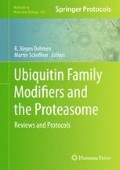Abstract
The elucidation of protein–protein interaction networks can provide preliminary insights into the function of uncharacterized proteins based on the interactions they establish in the cell. Here, we describe a protein immunoprecipitation protocol that can be used in combination with mass spectrometry analysis to identify the p97 interactome as well as specific subgroups of proteins interacting with its UBX-domain adaptors. This approach aims to dissect the role played by individual UBX cofactors within the complex array of cellular functions performed by p97.
Access this chapter
Tax calculation will be finalised at checkout
Purchases are for personal use only
References
Golbik R, Lupas AN, Koretke KK et al (1999) The Janus face of the archaeal Cdc48/p97 homologue VAT: protein folding versus unfolding. Biol Chem 380:1049–1062
Moir D, Stewart SE, Osmond BC, Botstein D (1982) Cold-sensitive cell-division-cycle mutants of yeast: isolation, properties, and pseudoreversion studies. Genetics 100:547–563
Peters JM, Walsh MJ, Franke WW (1990) An abundant and ubiquitous homo-oligomeric ring-shaped ATPase particle related to the putative vesicle fusion proteins Sec18p and NSF. EMBO J 9:1757–1767
Frohlich KU, Fries HW, Rudiger M et al (1991) Yeast cell cycle protein CDC48p shows full-length homology to the mammalian protein VCP and is a member of a protein family involved in secretion, peroxisome formation, and gene expression. J Cell Biol 114:443–453
Leon A, McKearin D (1999) Identification of TER94, an AAA ATPase protein, as a Bam-dependent component of the Drosophila fusome. Mol Biol Cell 10:3825–3834
Muller JM, Deinhardt K, Rosewell I (2007) Targeted deletion of p97 (VCP/CDC48) in mouse results in early embryonic lethality. Biochem Biophys Res Commun 354:459–465
Ye Y (2006) Diverse functions with a common regulator: Ubiquitin takes command of an AAA ATPase. J Struct Biol 156:29–40
Ye Y, Meyer HH, Rapoport TA (2001) The AAA ATPase Cdc48/p97 and its partners transport proteins from the ER into the cytosol. Nature 414:652–656
Alexandru G, Graumann J, Smith GT et al (2008) UBXD7 binds multiple ubiquitin ligases and implicates p97 in HIF1alpha turnover. Cell 134:804–816.
Schuberth C, Buchberger A (2008) UBX domain proteins: major regulators of the AAA ATPase Cdc48/p97. Cell Mol Life Sci 65:2360–2371
Buchberger A, Howard MJ, Proctor M, Bycroft M (2001) The UBX domain: a widespread ubiquitin-like module. J Mol Biol 307:17–24
Hurley JH, Lee S, Prag G (2006) Ubiquitin-binding domains. Biochem J 399:361–372
Zachariae W, Shevchenko A, Andrews PD et al (1998) Mass spectrometric analysis of the anaphase-promoting complex from yeast: identification of a subunit related to cullins. Science 279:1216–1219
Towbin H, Staehelin T, Gordon J (1979) Electrophoretic transfer of proteins from polyacrylamide gels to nitrocellulose sheets: procedure and some applications. Proc Natl Acad Sci USA 76:4350–4354
Wray W, Boulikas T, Wray VP, Hancock R (1981) Silver staining of proteins in polyacrylamide gels. Anal Biochem 118:197–203.
Acknowledgments
This protocol was established while G.A. was a postdoctoral scholar at the California Institute of Technology in Pasadena, CA. We thank Susanne Bandau for critical reading of the manuscript.
Author information
Authors and Affiliations
Corresponding author
Editor information
Editors and Affiliations
Rights and permissions
Copyright information
© 2012 Springer Science+Business Media, LLC
About this protocol
Cite this protocol
Alexandru, G. (2012). Exploring the Role of p97 and Its UBX-Domain Cofactors Through Identification of Their Interacting Proteins. In: Dohmen, R., Scheffner, M. (eds) Ubiquitin Family Modifiers and the Proteasome. Methods in Molecular Biology, vol 832. Humana Press. https://doi.org/10.1007/978-1-61779-474-2_21
Download citation
DOI: https://doi.org/10.1007/978-1-61779-474-2_21
Published:
Publisher Name: Humana Press
Print ISBN: 978-1-61779-473-5
Online ISBN: 978-1-61779-474-2
eBook Packages: Springer Protocols

